Real Madrid faced Eibar in La Liga on Saturday in the cold and rain of the Estadio Santiago Bernabéu looking to avoid a second defeat in four days, having been beaten by Valencia at the Mestalla in midweek. The historic thrashing that Santiago Solari received in his first game in permanent charge at Ipurua earlier in the season left a bitter taste in the mouth and Zinedine Zidane’s players were out for revenge.
It didn’t look much like that though, as Eibar took the lead through Marc Cardona early on in the first half to stun an empty Bernabéu. It was not until midway through the second half that the fightback began, with Karim Benzema heading in from Marco Asensio’s cross, only to go on to head in a winner several minutes later.
Our tactical analysis will use statistics to identify what key points Zidane can take from the game as his team returned to winning ways, despite seemingly having little to play for.
Lineups
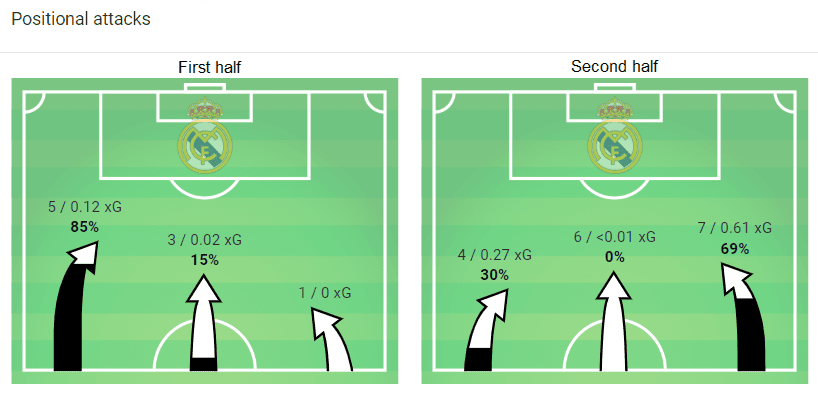
Sergio Reguilón, Federico Valverde and Gareth Bale grabbed the headlines for the lineups as the trio all returned to starting action. Zidane continued his policy of rotation with his team but refused to underestimate Eibar, going with his first choice attacking trident.
Eibar were forced into a last-minute change of their own, bringing Barcelona loanee Cardona into the side in place of midweek hero Pedro Leon just 15 minutes before kick-off. He joined fellow Culé Marc Cucurella in the lineup, featuring Eibar’s preferred 4-1-4-1 shape.
Pinned back by Eibar’s direct style
Whilst Real Madrid’s opposition usually average 39 long balls per game, Eibar recorded 65 on Saturday. It was the highest figure any rival team has recorded against Los Blancos since the two teams met in November. Throughout the first half, it kept the hosts pinned back in their own half as they struggled to find a way out from Eibar’s defensive and deep midfield playing long passes into the danger zone.
Real Madrid handled the threat well, winning 53% of aerial duels, above their average. Where they did struggle was to find an escape route to release the pressure. In the first half, the home team made just 23 passes into the final third with a poor 59% accuracy, meaning that they achieved less than half of the completed passes into the final third that Eibar managed (27 successful from 36 attempts).
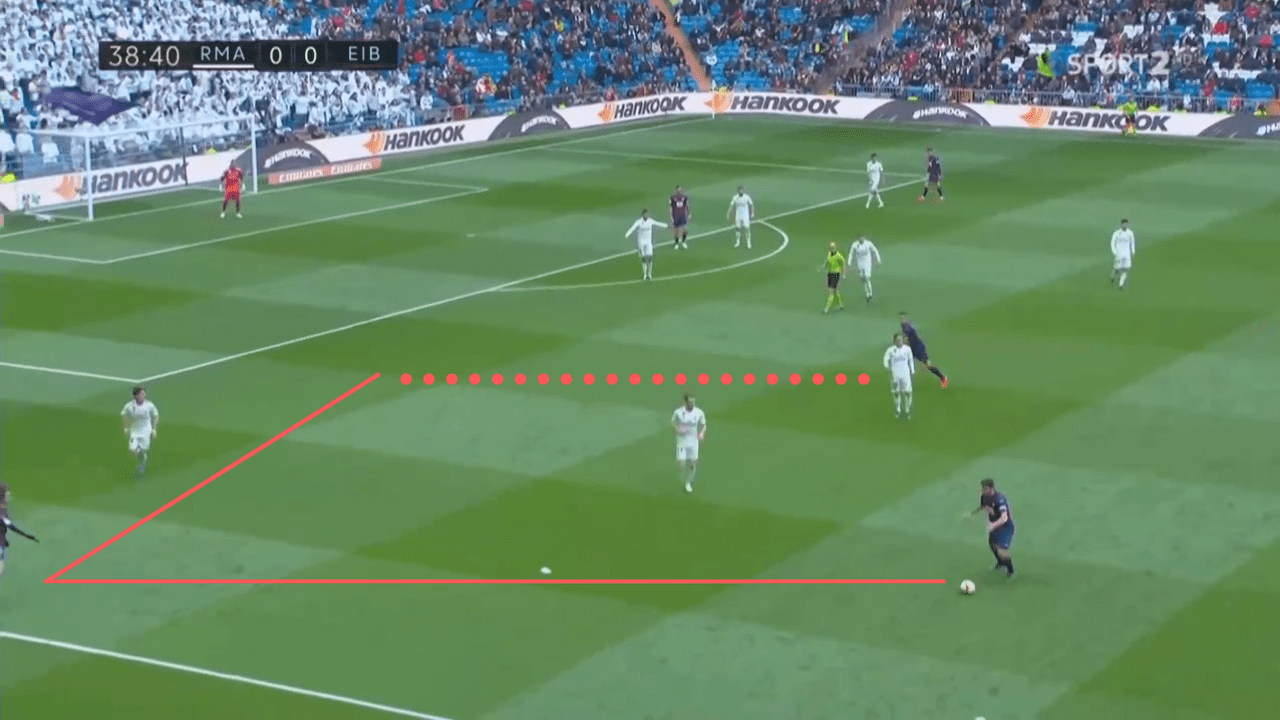
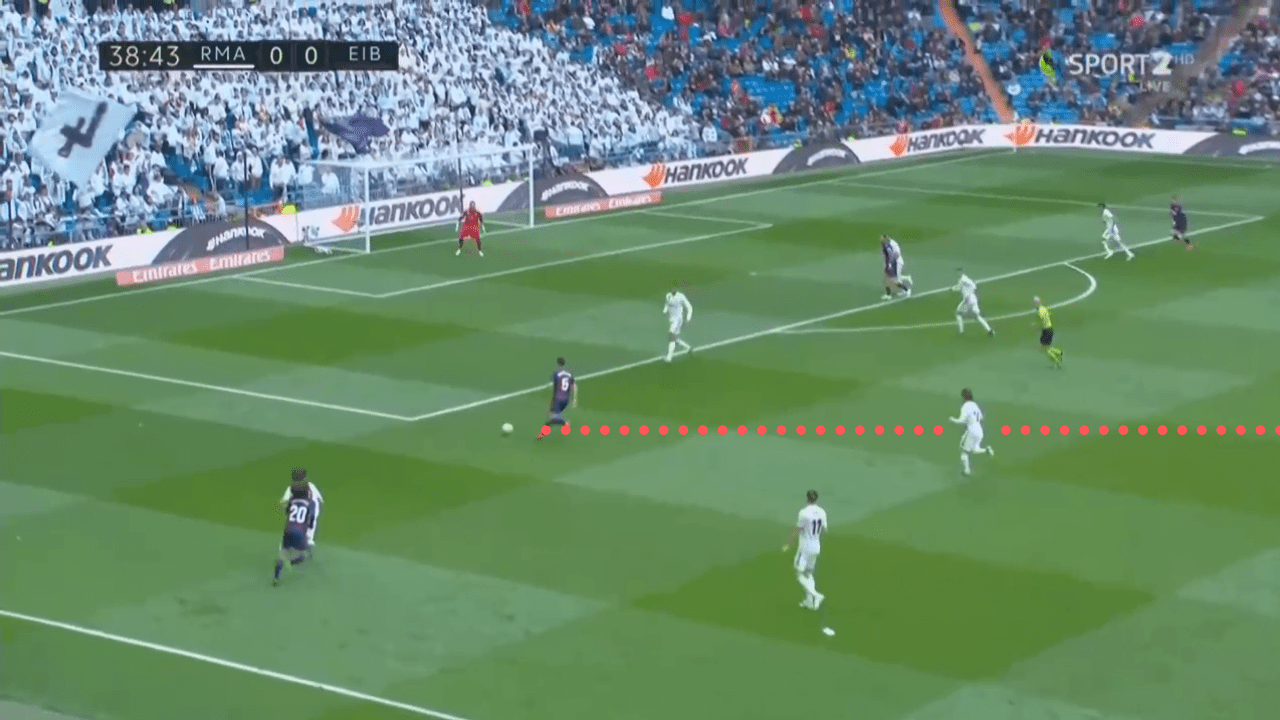
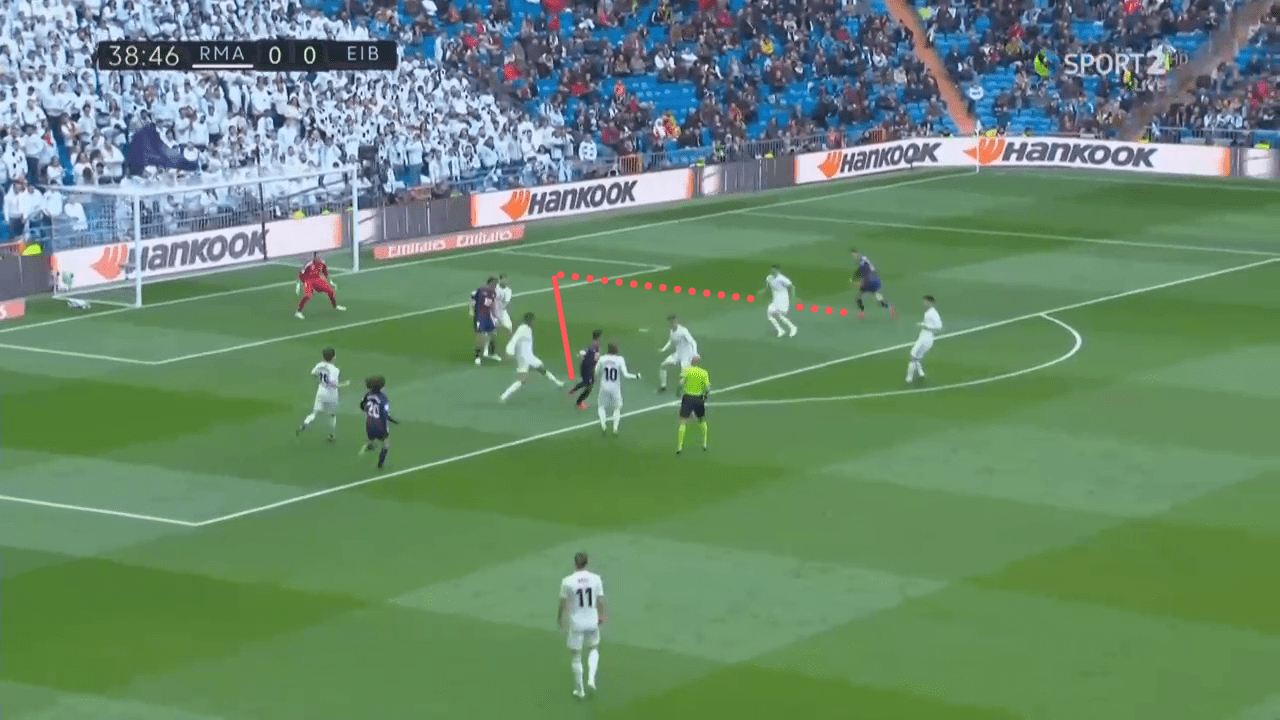
The opening goal, as shown above, reflected how Eibar provided the surprise factor which proved to be deadly. While Eibar had managed to pin back Real Madrid through the long-ball approach, it was yet to bring about any dividends in front of goal without a single shot on target despite restricting much of play to the Madrid half.
That was until Eibar spread the ball wide as usual, only to play it short instead. Rather than playing the deep cross that many expected, with Valverde sitting deep with his defence on the far side, Sergio Escalante made the run behind Luka Modrić to exploit space on the edge of the box. Caught out by the runner inside, Reguilón lost his concentration and allowed Cardona in behind to score.
One switch to change the game
That all changed in the second half thanks to Zinedine Zidane’s tactical change which would have a huge impact on the rhythm of the game. It was a simple change, swapping Asensio and Bale on the flanks to move the Spaniard to the right, but it would help get the best out of the younger of the two and would prove to be decisive in the game. In the second half, 11 of 17 attacks come down the flank, as opposed to five of nine in the first half, and it produced 99% of the xG, whilst there was no luck through the middle.
Once on the right, Asensio was far more confident in taking men on and looking to get at Eibar defenders. With seven progressive runs, a joint high since joining the club, and 12 dribbles, more than in any other game since May 2017, it was clear that Asensio was given free reign and was boosted in his confidence. With Zidane’s backing, he produced three shot assists, including one for Benzema to open the scoring, and had three shots himself.

As Asensio ran riot on the right, it was less positive for Bale on the left. Recording just 50% pass accuracy, his lowest ever return in a Real Madrid shirt, alongside 18 possession losses, his joint highest for the club since October 2016. Eibar targeted him again, as they did in the return fixture which was the only other game in which he lost possession 18 times, and pressed him every time he got on the ball. Without a shot on target and without any shot assists, it was another afternoon to forget as he was whistled throughout.
Crossing is key
By making so much of their play come down the flanks, it is perhaps no surprise that both goals came from crosses into the box. Not since January 2017 have Real Madrid had such a high success rate with their cross conversion ratio, reaching 59%. Asensio recorded five crosses, whilst Bale managed two, with support also coming from the full-backs as Álvaro Odriozola and Reguilón added a further seven between them. With such a threat delivering balls into the box, Eibar were under constant bombardment at some stages of the game.
It is also important to note the role of Benzema in these goals. Rather than just finding himself in the right place at the right time, his movement was essential. For the first goal, he found himself marked by two men but stepped behind one and in front of the other, perfectly positioned to rise above and head in. The second goal was similar, using his teammates as cover to break at the last moment and head in from almost exactly the same position.
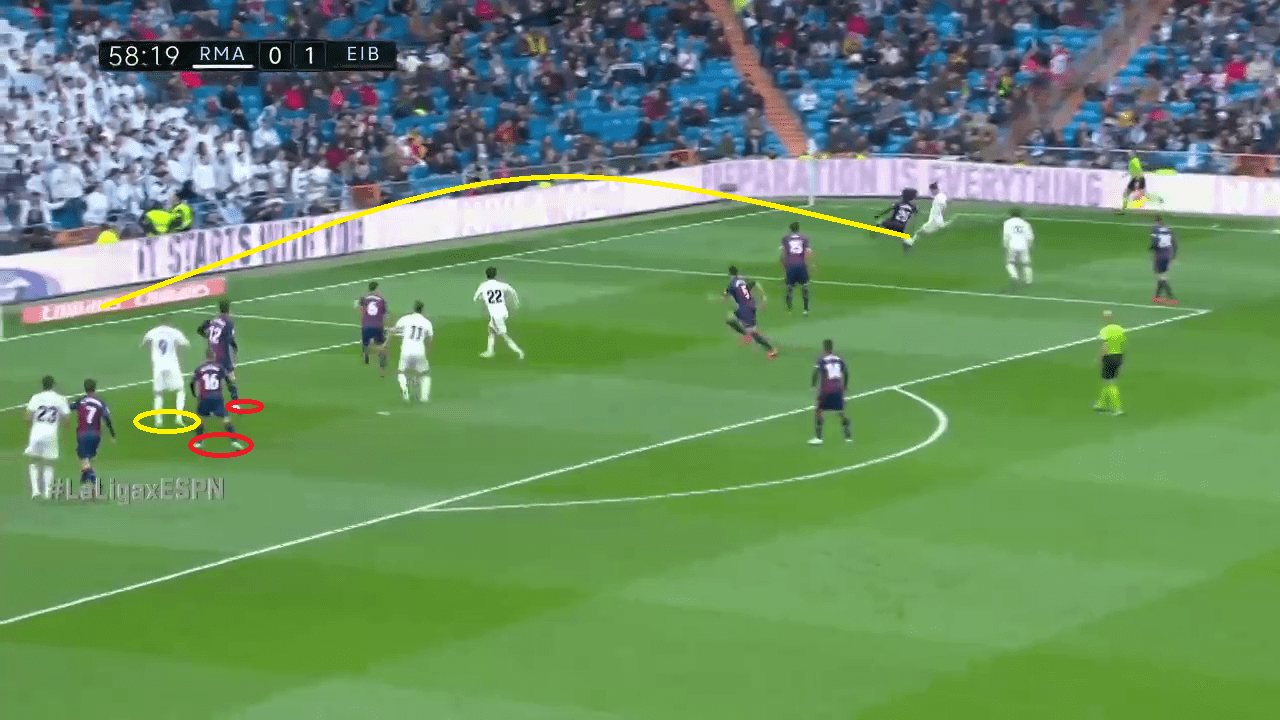
Coming against Eibar, one of La Liga’s strongest teams in the air, it was a brave approach and seemingly not the one that Zidane had from the offset. With Asensio in sparkling form though, it was the logical choice and one which brought about rewards for his team. Zidane will be reluctant to see his team become so predictable, where this approach may be less successful against the likes of Premier League sides more used to such a style. For now he will have been impressed by the way in which the tactical switch made all the difference.
Valverde’s future role?
Perhaps one of the more surprising choices came in midfield, where Valverde was selected to start in the so-called Casemiro role. The Uruguayan was making just his second start of the season in La Liga but immediately looked at home, producing a performance much more reminiscent of Marcos Llorente than the Brazilian. That came in how he helped the team to transition from defence to attack, particularly as they sought to find a way out of Eibar’s continual long balls into the box.
Where he showed similarities to Llorente and particularly stood out was late on, collecting the ball deep in his own half but not being afraid to carry the ball. Rather than simply playing the ball wide from the off and shifting possession, he made a 35-yard run which created a threat as Eibar were left with a three-on-three situation on the counter. Laying the ball off to Asensio bombing down the flank, he transitioned the play perfectly moving from under pressure defensively to a major counter-attacking opportunity.
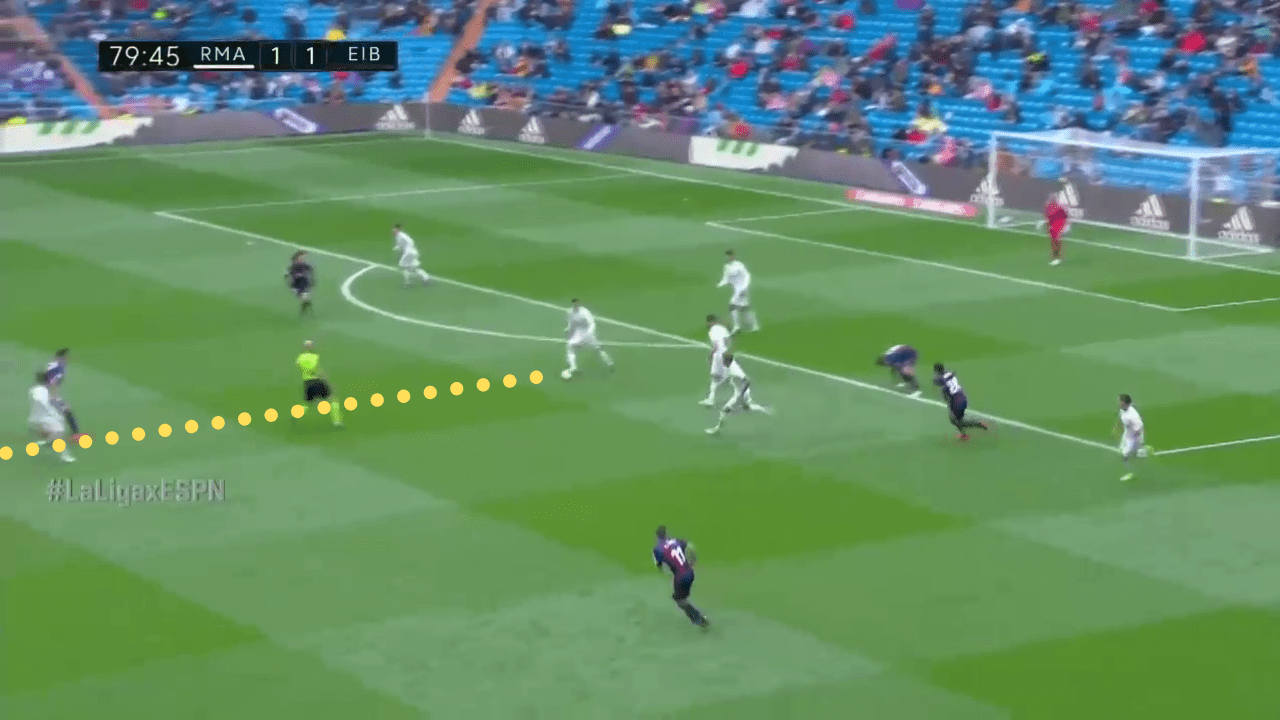
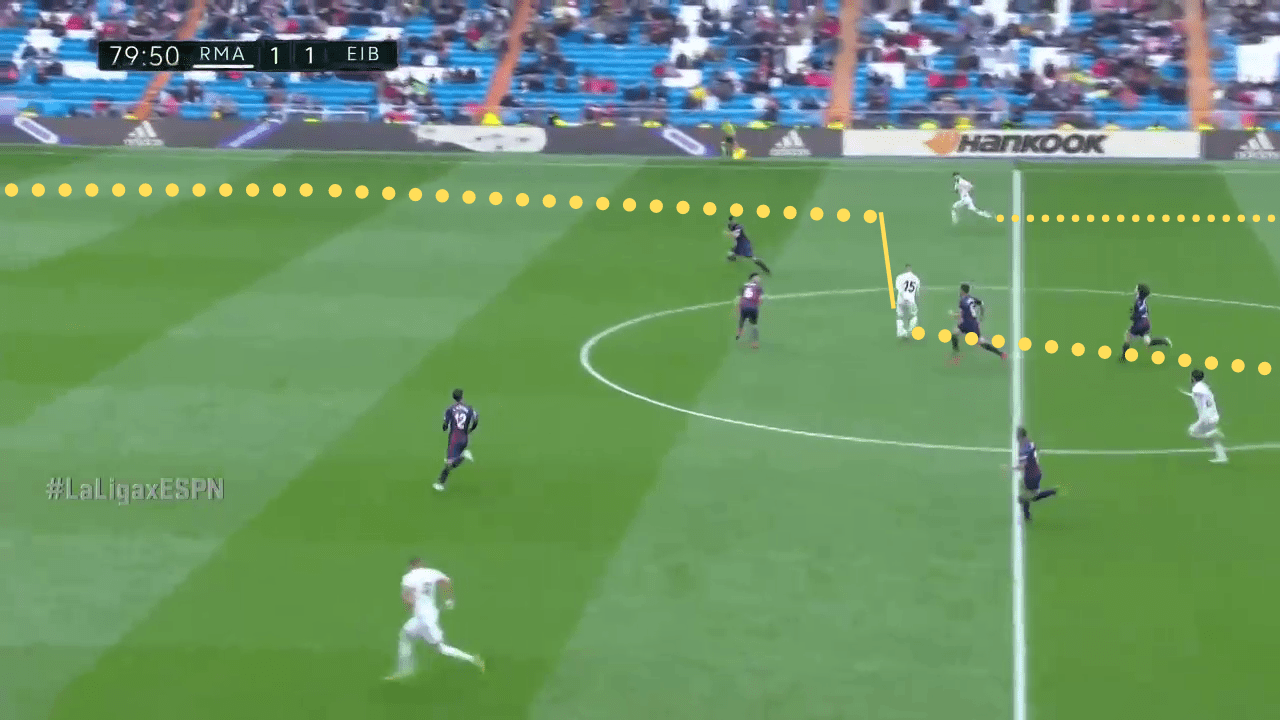
Recording eight interceptions and 11 ball recoveries, he deployed the defensive part of the role well. He read the game well and even though his position was often bypassed by Eibar’s direct approach, he dropped in to help out the backline.
Zidane is believed to be keen on retaining Valverde for next season and this may be the role that he will take up, rotating with Casemiro, though it would be a huge blow for Llorente’s hopes of staying in the Spanish capital.
Conclusion
On the face of it, this result is not as concerning as it could have been after a poor first half. Real Madrid struggled to adapt to the conditions and the approach of their rivals, but once Zidane was given a chance to analyse and make his changes, they worked to a tee. The decision to put Asensio onto the right flank produced his best performance of the season and one which provides real cause for optimism. Zidane can feel content that his team reacted in the way that they did, particularly following defeat midweek, but this side still look someway off the heights of his previous reign.
If you love tactical analysis, then you’ll love the digital magazines from totalfootballanalysis.com – a guaranteed 100+ pages of pure tactical analysis covering topics from the Premier League, Serie A, La Liga, Bundesliga and many, many more. Pre-order your copy of the April issue for just ₤4.99 here, or even better sign up for a ₤50 annual membership (12 monthly issues plus the annual review) right here.

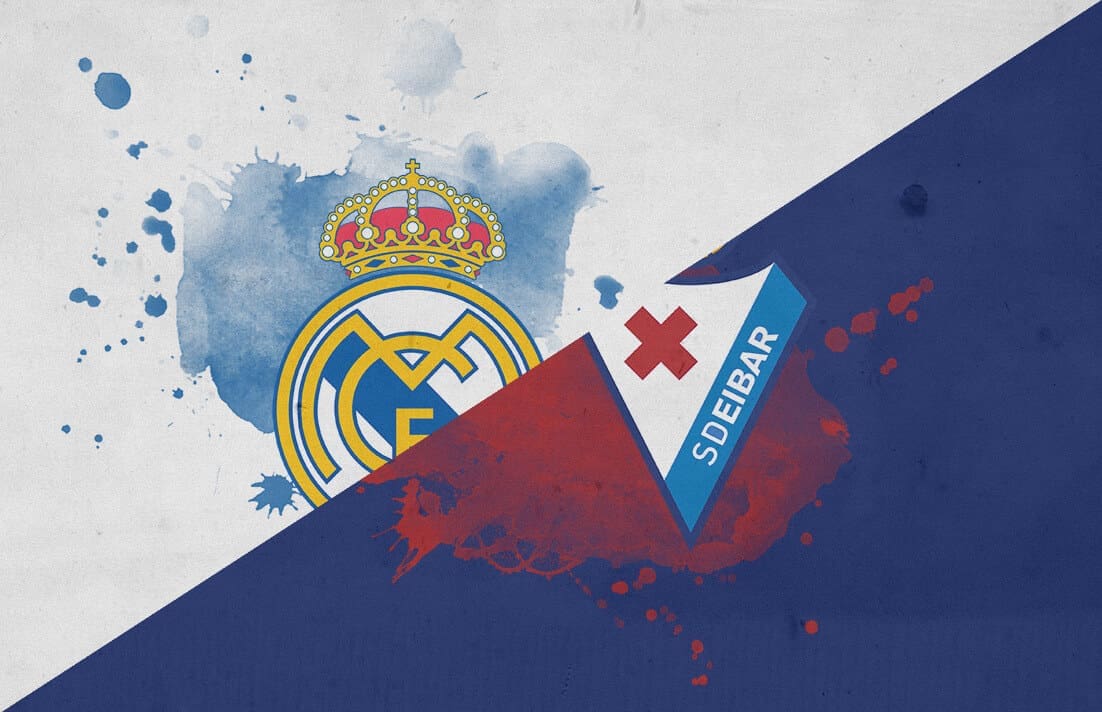



Comments